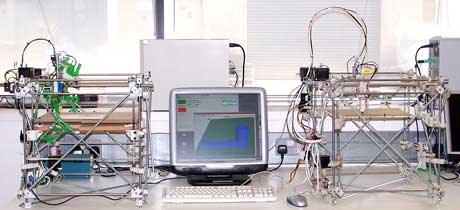The idea of a machine that could produce a copy of itself has intrigued some of the greatest minds in history. Rene Descartes heads a list of philosophers, mathematicians and physicists who have long pondered the potential of a self-replicating machine. As have writers of science fiction, who have been also quick to warn of the dangers of unleashing such a powerful technology upon the world. But for both sets of thinkers, the reality of a self-replicating machine has lain somewhere just beyond our reach.
Sitting in his office at the University of Bath, Dr Adrian Bowyer doesn't look like an evil mastermind. Bowyer is a quietly spoken, slightly podgy, twinkle-eyed 55-year-old senior lecturer at the school of mechanical engineering and inventor of the RepRap machine. Earlier this month at Cheltenham's Science Festival, Bowyer and New Zealand scientist Vik Oliver unveiled a RepRap that had the majority of its working parts "printed out" from an earlier prototype. Although the RepRap was first assembled in 2006, this was the first time a parent and child machine had appeared side by side.
Technically, the RepRap is a form of rapid prototyper, the kind used by designers and engineers to streamline everything from aircraft to hairdryers, but it's easier to think of it as a printer of three-dimensional objects. Essentially, the RepRap works like the desktop printer you might have at home, but instead of printing on paper, the RepRap makes hard copy in three dimensions out of plastic from models designed on a computer.
Growth potential
Even before you get into the benefits of self-replication, the RepRap is already an impressive achievement. Bowyer and an army of international helpers - all operating under an open-source licence that lets them adapt and develop the blueprint collectively - have managed to scale down the cost of rapid prototypers from tens of thousands of pounds to around £250. But it is the RepRap's ability to produce its own parts (which could then produce another machine and so on) that has won Bowyer acclaim from the likes of the inventor James Dyson and executives at Google.
Bowyer describes his RepRap as "potentially an extremely powerful technology" that could "give everybody - ultimately - the ability to make virtually anything for themselves in return for being helped to reproduce". For the moment it makes crude plastic knick-knacks (sandals, coat hooks, door handles and fly-swatters), but it has the potential to develop into something that could make much more sophisticated artefacts, including the ability to lay its own circuitry.
The RepRap itself is a humble thing to see. It's small, little bigger in volume than a portable television, barely more than a frame assembled from long pieces of screw-grooved studding and a large number of plastic parts. At its heart is the all important extruder, which is poised to squeeze out a small film of molten plastic from a nozzle that is fed from a coil of white filament. It looks vaguely like a cut-price textile machine.
Bowyer sets the nozzle to work, producing a simple coathook. Line by line, layer upon layer, the RepRap begins its task. It is an agonisingly tedious process that will take it almost two hours to "print out" each small part. It will take hundreds of hours to make the parts for a "child" machine. Not that that should temper your enthusiasm. If you think back, the first digitised images took hours to process. Now, 20 years later, such things are commonplace, done in a flash on a mobile phone.
Seen it before?
If you are still not convinced, perhaps it helps to take a longer view. The idea of a self-replicating machine can be traced back to remarks made by the Queen of Sweden to René Descartes, but they were more seriously explored in the 19th century by Samuel Butler, who described a machine that could mimic the biological process of plants in his novel Erewhon.
Science fiction writers have kept pace. Phillip K Dick, Arthur C Clarke and Nobel-nominated Karel Capek have all toyed with the idea, before John Sladek based his 1968 satirical novel, the Reproductive System, on a self-replicating machine that goes wild. It set the scene for movies like the Terminator to tap into fears of robots capable of reproducing and taking over.
Bowyer thinks his RepRap will prove much more benign. Besides, his machine can't self-assemble and cannot yet reproduce all its own parts. These last two points do make you wonder if the RepRap is a self-replicating machine at all. A lathe could be used to make parts for another lathe; what's so different about his RepRap? "You could see the whole of engineering as effectively a self-replicating machine," Bowyer says. "It's very difficult to use a machine tool to make another copy of itself, but RepRap is designed to make that as easy as possible."
Even though the RepRap is a doddle to operate, it remains difficult to build. To do so you have to have an ability to write your own computer code, be confident with a soldering iron and have some grasp of mechanics. It is believed that there are already around 100 RepRaps in the world, mostly made by small groups who share the skills necessary to build one. Bowyer thinks this model is perfectly suited to small groups to develop products who would otherwise struggle in normal economic circumstances. "It means that communities in the developing world manage to get one foot on the rung of the manufacturing ladder," he says.
"Even in China you have to spend half a billion [dollars] to create a fabrication line. You can pay people low wages but you have to make an enormous capital investment in order to make things. The thing about RepRap is that it allows you to make stuff with a very small capital investment. If you are a community that has one, you can have several machines once you have got one and what's more you can give a machine to your neighbours down the road and they can do the same thing. [It's] a very powerful mechanism for elevating people from the most extreme poverty."
Recycle, again
Soon, he says, communities in places like Africa will be able to download instructions for a RepRap and use it to replicate further machines, almost endlessly. Because the plans are open source, such communities will have to pay no royalties for the patent. But, he adds, such a noble stance is inevitable: "I realised that if you have a self-replicating machine, you've got to give it away anyway because there's nothing to sell. If I knock it out for £1,000 you can replicate it and knock it out for £900. Sooner or later you are down to the cost of the raw materials."
And there is, he says, no fortune in that and, anyway, he doesn't want to spend the rest of his life in court trying to prevent people from doing with the machine the one thing it was designed to do. "You are brought to the point where you have to say 'this is a self-replicating machine, the only sensible thing do is give it way for free'."
The RepRap needs to get much faster before it can even begin to realise its potential, but it is still early days for a device - even though it has been dreamt of since the dawn of the enlightenment - and Bowyer is not done yet. Soon, he plans to design a shredder for the machine, so old items created on the RepRap can be returned to granules of plastic to be reused. Think about it, he says: "You could shred your milk bottles and make a pair of sandals. What's more, when the child grows out of the shoes, you shred them, add another milk bottle, rescale the design and you have a new pair." If nothing else, the RepRap could be the ultimate recycling machine.






















